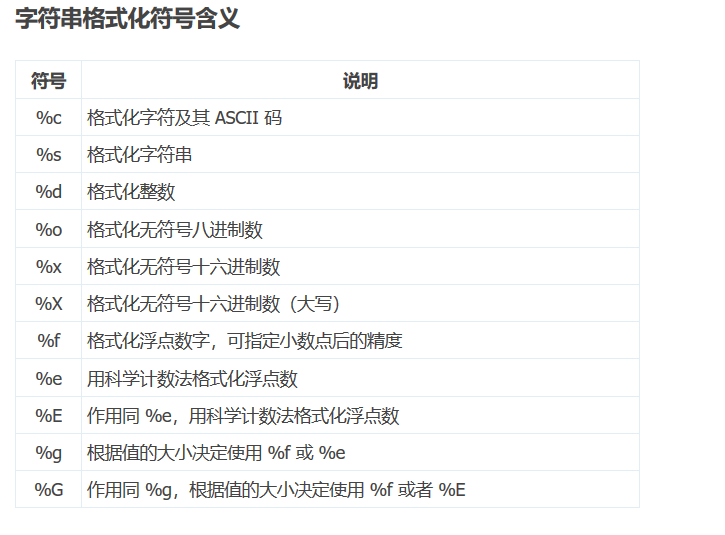拼接
+加号拼接name='zs' print('hello,'+ name) #输出结果: hello,zs,逗号拼接name='zs' print('hello,', name) #输出结果: hello,zs
占位符方法
name='zs'
print('hello,%s'%name) #这里 s% 就是一个占位符,为“字符串”占位
#输出结果:
hello,zs常见占位符:

为输出设置限制条件:
- %3s 表示输出的字符串类型最少 3 个字符,少于 3 个用空格填充
- %.5s 表示输出的字符串类型最多 5 个字符,超出 3 个会被删掉
- %3f 少于 3 位数,小数点后面用 0 填充
- %.3f 控制小数点后的位数,保留 3 位小数。
下面补充一些相关知识:转义符

格式化输出
第一种:
name='zs'
print(f'hello,{name}')
#输出结果:
hello,zs第二种:
name='zs'
print('hello,{}'.format(name))
#输出结果:
hello,zs在大括号里
{}指定位置参数:print('{1},{0},{1}'.format('abc',18)) #输出结果: 18,abc,18格式控制信息还包括【填充】,【对齐】,【宽度】,【千位分隔符】,【精度】,【类型】等。
print('{0:30}'.format('python')) #宽度 #输出结果: python #python 字符后面有空格的,总长度 30 print('{0:>30}'.format('python')) #对齐 <,>,^ 分别表示左对齐,右对齐,居中 #输出结果: python print('{0:*^30}'.format('python')) #填充 #输出结果: ************python************ print('{0:-^20,}'.format(123456456789)) #逗号为千位分隔符 #输出结果: --123,456,456,789--- print('{0:.2f}'.format(123.45645)) #精度控制 #输出结果: 123.46 print('{0:.4}'.format('python')) #字符分割 #输出结果: pyth print('{0:.2%}'.format(3.14152)) #类型控制 #输出结果: 314.15%
更多用法详见官方文档:https://docs.python.org/zh-cn/3/library/string.html#format-string-syntax
欢迎各位看官及技术大佬前来交流指导呀,可以邮件至 jqiange@yeah.net